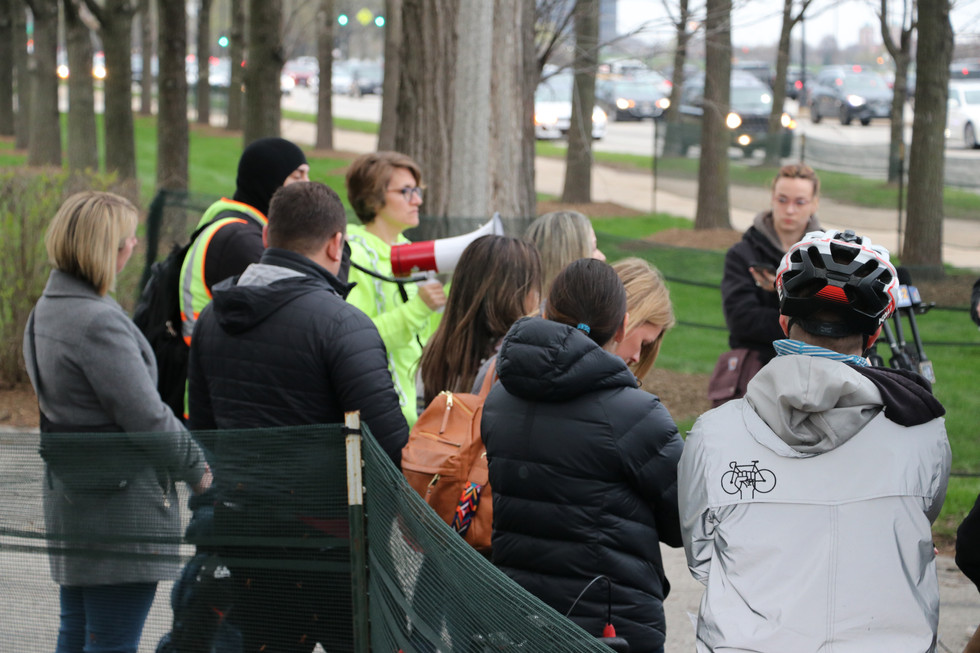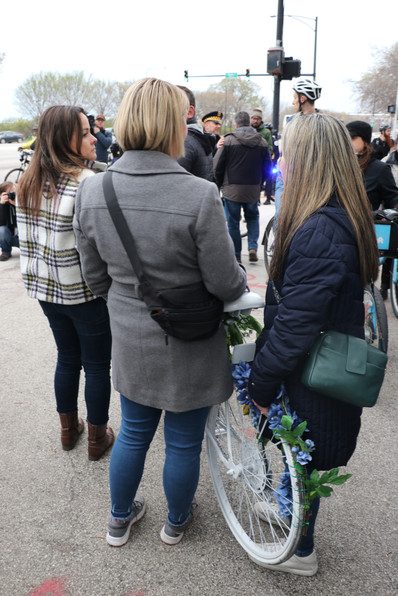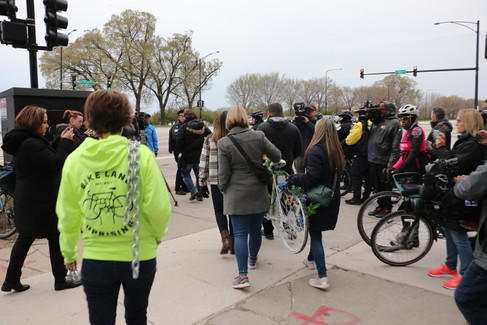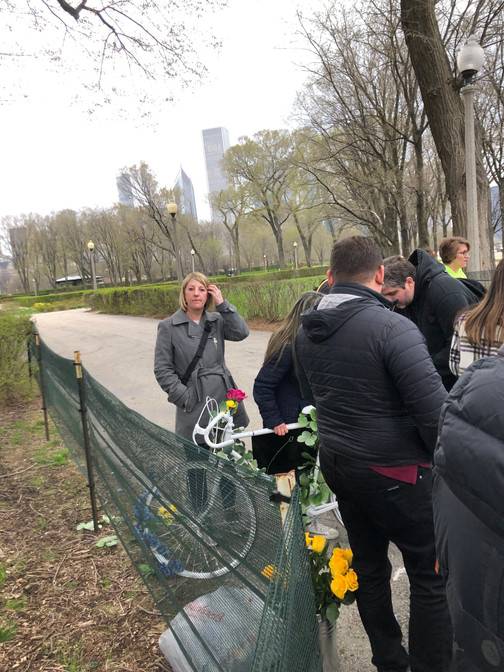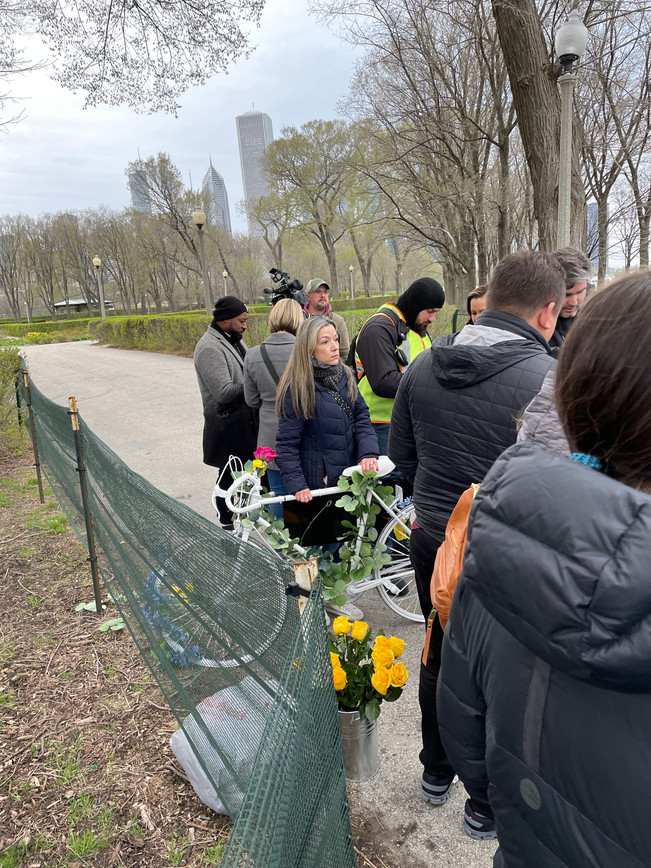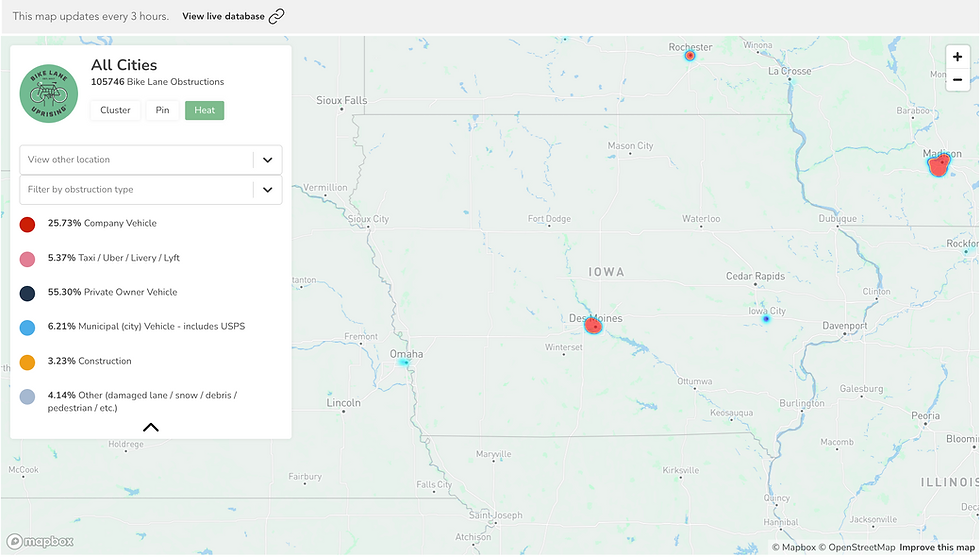Victims of Chicago's Traffic Violence
- willhy
- Jul 12, 2022
- 6 min read
A “ghost bike” is a memorial bicycle that has been painted white, placed where a bicyclist was killed, and remains as a warning and reminder to others.
Written by: Bike Lane Uprising Volunteer

In Chicago I cross several ghost bikes weekly that are familiar fixtures to me, and I remember others that are gone now. I regularly biked past Jacqueline Marie Michon's downtown on Wabash near Wacker until the city removed it. The sign on Liza Whitacre’s ghost bike on Damen Avenue always catches my eye. I remember reading about the death of Anastasia Kondrasheva and seeing her ghost bike not long after. I keep a list of Chicago bikers whose final spots I have visited either alone or as part of a memorial event. Carla Aiello, Isaac Martinez, Adé Hogue, Jose Velásquez, Gerardo Marciales, and Nick Parlingayan most recently for me
Not only cyclists have memorials though. If not a white ghost bike then a bundle of flowers or a fragile wooden cross will mark the place where a person was mowed down by another person. A human body vs several tons of moving steel. Everyone knows who wins and who loses in that contest. Bicyclists, pedestrians, and children don't have airbags and reinforced steel beams to protect them while they're out enjoying the streets. I wish I never had to learn the term “traffic violence”, but I feel it most accurately describes the recent deaths of two year old Raphael "Rafi" Cardenas, three year old Elizabeth "Lily" Grace Shambrook, and 11 year old Ja’lon James.

Gerardo Marciales' recent death and ghost bike installation impacted me more than others, and I wasn’t sure why at first. When I crossed the street where Gerardo’s family and friends stood the evening of his memorial I couldn’t make eye contact. I tucked myself away off to the side of the crowd. His fiancé commented to the news outlets about Gerardo's inclination to bike. Why use a car in a city like Chicago when he didn't need it, he would ask. I share that mindset. I bike for transportation, for fun, for fitness. I bike because I don’t want or need to own a car. I bike because I grew up with family bike rides. I bike because it’s an American pastime proved by a cycling club older than the first automobile. I bike because I love the freedom and independence it grants me, and no-one should have to worry about dying if they feel the same way.
Before Gerardo’s death I did not know that hundreds of drivers purposefully run the red lights on Lake Shore Drive (U.S. Highway 41) every day. I would not have believed it if I hadn’t seen it myself. It sounded absurd to me, but then I stood out there where Gerardo had been killed. I stood on a thin oasis of concrete barely large enough to fit his ghost bike, between eight lanes of traffic, and in 10 minutes I saw an endless stream of drivers running the red lights. This is what killed Gerardo. Not only a dangerous decision by one driver, but a flawed design and complete absence of enforcement so that people feel empowered to drive dangerously. All these drivers knew that they would not be held accountable for their behavior. This was no accident. This was negligence by a driver and negligence by a city government. The police let us know they intended to take down Gerardo's ghost bike shortly after it was installed since it could be a "distraction" to drivers. Drivers with cell phones, billboards, radios, and in-car computers might be distracted by a reminder of their responsibility, and apparently that was too much to ask.

Killing a bicyclist with a car is a shortcut to punishment-free manslaughter. Whether it’s due to malice, negligence, poor infrastructure, or some combination of those and other factors it is the driver of the car who has a duty to keep vulnerable people safe, and it is their failure in that duty when someone dies. In American society we teach drivers that running over cyclists and pedestrians is a minor annoyance and not likely to to result in any consequences.
On my way both to and from Gerardo’s place of death I witnessed, as I routinely do, several drivers (including police officers) who had illegally parked their vehicles putting bicyclists in danger. I used to report abuses of infrastructure and unsafe driving to the city of Chicago in the hope that I could make an impact and help conditions improve. Chicago’s 311 system has a category specifically for bike lane obstructions, but all support requests to 311 for bike lane obstructions are immediately and automatically closed. Closed with no resolution. Closed with no action taken. Closed. A dead end. I stopped reporting these incidents to the city months ago, and only continued again recently. Even if the city won't act, I will continue to complain, but I won't hold my breath that they will do anything meaningful with the information I give them.
Chicago issued only 1,263 tickets for vehicles parked in bike lanes (MCC 9-40-060) in 2021, averaging barely three tickets a day. A quick look at one independent source of data shows that the daily average number of violations is actually much higher than Chicago's rate of enforcement implies. Querying the Bike Lane Uprising database it appears that the actual number of bike lane violations daily must exceed 100, and that estimate is based on a small fraction of data points that happened to be seen, photographed, and logged in one particular volunteer-driven system.
Gerardo didn’t die because a person obstructed a bike lane, but three year old Lily Shambrook did. Whether it's blocked bike lanes or speeding drivers the common factor at play is a failure to discourage dangerous driving, and a glaring lack of infrastructure for non-drivers. The same neglect of bike lanes, crosswalks, pedestrian resources, sidewalks, and the lack of consequences for dangerous and negligent driving all go hand in hand. Adults, children, wheelchair users, scooter users, bicyclists, are all incredibly vulnerable when put in direct conflict with a driver and their car. "Share the road" feels like a ridiculous slogan when riding a 30lb bike next to a 4,000lb car. The stakes for drivers and bicyclists aren’t the same.
I did not know Gerardo and he did not know me. Maybe we passed one another on the street at some point, but neither one of us would have known. Despite that, I was like him, and he was like me. Two bikers who wanted to enjoy our city. It's one thing for the city to paint bike lanes, but if nothing stops cars from parking and driving in them, then what's the point? If drivers can bypass red lights with impunity, what good are they? Seeing blatant safety violations every day and knowing the city doesn't care to enforce them infuriated me. This is why innocent adults and children are dead. These lives were taken in the name of driver convenience rather than the enforcement of stricter standards for non-driver infrastructure. The eight lane highway where Gerado was killed separates Chicagoans from Lake Michigan, one of our greatest natural resources, but the status quo is maintained to not inconvenience drivers. ComEd obstructed a bike lane and failed to exercise due care and caution and a child is dead. We accept tearing apart the lives of people who want to calmly enjoy the city for the convenience of people who "need" to drive through it.
During recent construction in Chicago a temporary bicycling detour was created. Chicago's Department of Transportation accidentally created the safest bicycling infrastructure that had ever existed in the city. This is temporary though, and will be removed.
Deaths like Gerardo’s and Lily's are often labeled “accidents” with the implication that they were flukes, like a lightning strike; an unstoppable chaotic inevitability, but these deaths aren't the result of random accidents. These are crashes, and they are avoidable. In all these traffic violence deaths a human being operating a motor vehicle caused a crash and ended a human life. The driver who crashed into Gerardo will receive a ticket and little more. ComEd, who frequently undermines bicycling infrastructure for their own convenience, will suffer no consequences for creating a hazardous environment that resulted in a death.
Gerardo, Lily, and all these other victims of traffic violence wanted to get from point A to point B, just like me, and now they are gone because of irresponsible drivers and a government that fails to hold individuals, companies, and even their own police department responsible for their deadly and lazy choices.











